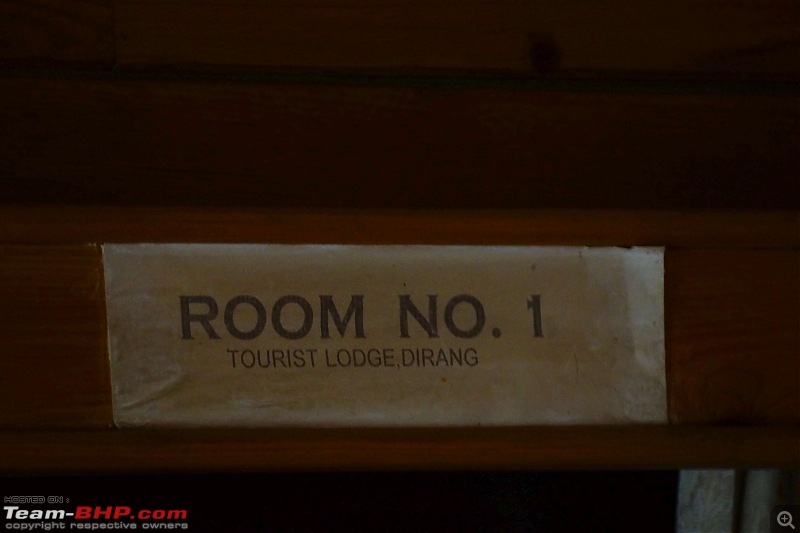Team-BHP
(
https://www.team-bhp.com/forum/)
-
Travelogues
(
https://www.team-bhp.com/forum/travelogues/)
Trivia:
The residents of Tawang love any reason for a picnic, as long as there's a holiday and nice, clear weather. Pack up homemade food and pile in 15 to a Maruti Omni, stop at the nearest empty meadow and spread out those sheets to have a great family time over loads of food. That's what we discover on our way back to town from the Ani Gompa.
Very inviting, I must say!




================================================== ==
Trivia:
Very few of the local men like working in the BRO road widening projects, and the BRO thinks productivity by women-only labour forces is lower. So they have brought in large work forces from BR, WB and western UP to work for them.
Lately, with the job situation improving their own states, fewer and fewer people from these states are available. Some have decided to stay behind in Tawang and other areas, though they don't work for the BRO road projects, but have set up their own small businesses and doing quite well.
This is after all a car forum. And what's a car forum without a post about cars in it? The restorers and off-roaders among us tend to lose interest in a boring travelogue that talks about monasteries and picnics, right? :D So let's talk about a restorer's delight. At the next place we visit, we discover this Gypsy sitting there, all ready to be inspected. And inspect it closely we certainly do! Only thing is, neither do we have any idea of why it's there, nor can we figure out who might want to buy and restore it, and take it down the mountains from Tawang.
Obviously, there are no OTR fans in Tawang! lol:
How can shopping be excluded from a trip anywhere?
The people of Tawang possess great skills in craftsmanship which is quite apparent in the beautifully designed traditional and artistic crafts. These crafts are also available in the Government Crafts Centre, aka the Tawang Emporium.
Wood carving works, hand-woven carpets, utensils made of bamboo and wood, Thanka painting and hand made paper are the usual products. Some of the artefacts made of wood are the wooden mask which is used in the religious masked dances performed during festivals.
Dolom is an artistically designed eating bowl with lid made up of wood.
Sheng-Khlem is a spoon made of wood.
Gruk is a cup made of wood used for serving tea.
So off we go looking for the Crafts Village, where a collection of artisans live, create and sell there wares directly from their homes. Unfortunately, they're all out enjoying themselves at their picnics, and all the places are shut.
The next best option is to go and visit the government-operated Tawang Emporium, and we spend some time here, going through the interesting products arranged on the basis of the different districts of Arunachal Pradesh where they are most common.
Daughter is suitably amused by the looks of the traditional Monpa headgear.
But the prices... Oh, the prices!!! Wife's expression says it all... :D

Incidentally, this is also where we find that Gypsy shown in the previous post. I'd hazard no guesses about what prices they might ask for THAT one!
It's getting darker, and it has started raining. We return to our lodgings, as the overcast sky pours even more vigorously. We are a little worried about landslides and road blockages, because early tomorrow morning we are going to make our way down from Tawang, to spend a night in Dirang.

The Tawang Circuit House with a backdrop of overcast sky.
We've had our fair share of visiting monasteries over the last few days. Feeling decidedly lazy in the morning after the night-long rain (and no barking dogs!), we are on the road by 6:30 AM. Now 6:30 AM in Tawang is like 8:30 AM in Gujarat - daybreak is at 4 AM here, and folks are up and about by 6 AM! But then, we aren't really going very far, just about 130 km to the town of Dirang.
It continues to drizzle all through the morning. We can afford to make frequent stops, and go slow over the slushy and bumpy roads.
We admire the marks that Zorro (BRO) left behind on the hillside.
We stop to photograph the Khinmey Monastery just outside Tawang, and decide against going there after a short debate, just because it's raining!

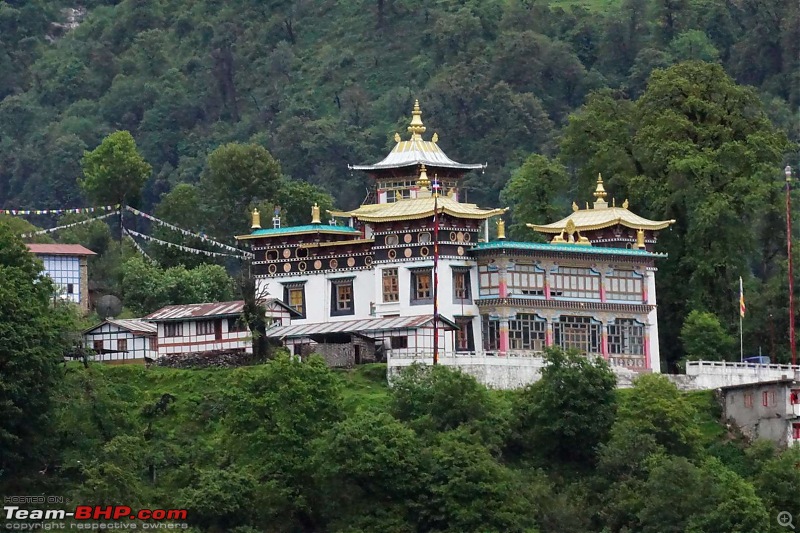
The streams and rivers are in spate after the heavy rain that fell the previous night, and the water froths like milk down the hillside.


A last wistful look, before we reach Jaswantgarh, in the direction of Tawang far away, though the clouds hide whatever can be seen on a sunny day.

I don't really have any urge to become (a part of) history right now :uncontrol, but the tea is sweet, milky and hot - perfect antidote for the drizzle and cold wind.

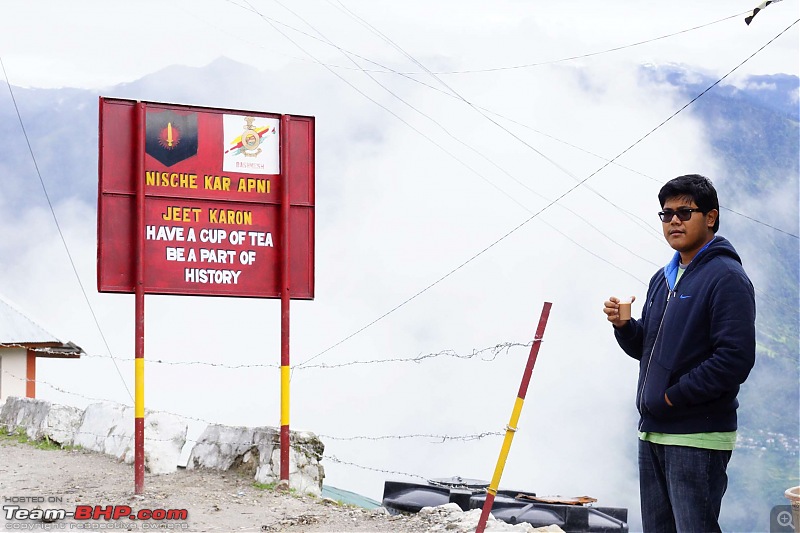
Remember, I'd mentioned that the Americans had been here?
Quote:
Originally Posted by SS-Traveller
(Post 3145954)
It is said that the Chinese had been here. No one told us the Americans had been here too. Mr. Stallone had visited this place and has a gate to his name. And this yak is going to be steak for dinner soon, with Texans living in the direction it's headed!
|
Now we end up discovering Burger King inside the tea stall at Jaswantgarh!
As we drive away, one more look at the Jaswantgarh Memorial from far away.

And then we are across the quite deserted Sela Pass too.
We check in at the Tourist Lodge, Dirang, just after midday.
Mr. Karchung, the manager, multitasks here - he is the receptionist, cashier, cook, gardener, housekeeper, cleaner and whatever else.

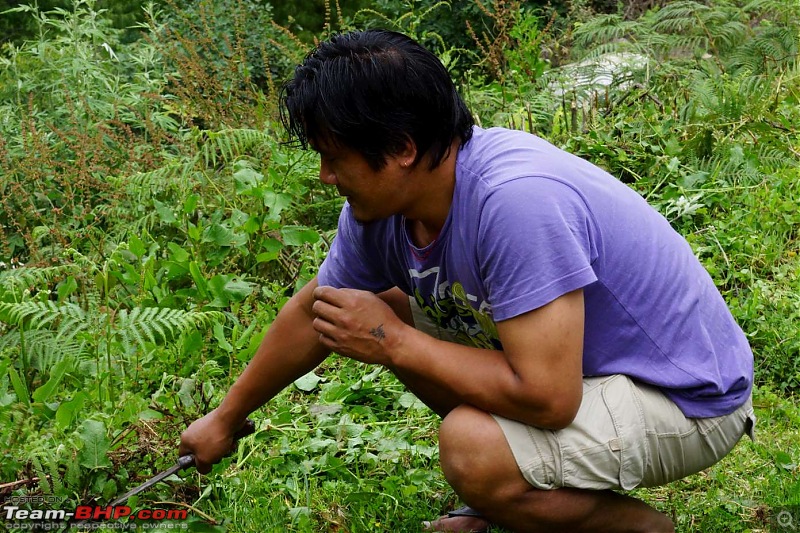
We are the only guests here for the night. The rooms are big and airy, the toilets are reasonably clean, with running hot water...
The rest of the afternoon is devoted to exploring Dirang and its surrounding areas. The first destination is the Dirang Fort, or Dirang
Dzong.
Dirang Fort is a significant historical structure of the Monpa tribe in the Dirang region and is said to have been built in 1831 (some say it was built in the 17th century). It is the only one of its kind in the whole region, strategically situated on the banks of the Kameng River.
The fort is not quite what you would imagine it to be after visiting forts in north India, especially around Rajasthan. It is a small fortified group of buildings up to 4 storeys high, in which the whole village could take shelter at times of conflict with other tribes. Even today, people continue to reside inside the fort, which is on an elevated hillock above the highway passing by next to it.
The architecture of the buildings inside is typical of other traditional buildings of that region, with the foundation made of large flat stones, and the walls and upper structure built of wood. The corrugated tin roof seems to be a persistent modern touch to all the buildings.
Realizing the importance of the monument recently, the archeological department has initiated moves to renovate the fort and also to declare it as a national monument. We are not sure whether the construction activity that we see inside is related to renovation or newer structures being put up.
Trivia:
Motorcycles are popular among youth in the towns at lower altitudes such as Bomdila and Dirang, but there aren't many of them up in Tawang. One good reason is that this part of the state does not have any motorcycle or car dealers, and purchasing / servicing a bike means a trip to Tezpur, the nearest place where showrooms and service centres exist.
However, as in all parts of the world, the real excitement of owning and riding a bike is how much one can modify it. Out here, though, the quality of mods isn't really anything to write home about - some mod jobs are pretty awful.
Let's just say this one is one of the better specimens I saw in Dirang.
We explore the other side of the Kameng River, crossing it over a steel bridge about 1 km upstream of the Dirang Dzong. We are in search of the Sangti Valley, which Mr. Karchung from the Tourist Lodge had mentioned is a picturesque spot.
Quote:
At a distance of 12 Kms. beyond Dirang is the famed Sangti Valley, Sangti is dotted with numerous picturesque spots, which are ideal for holidaymakers. One of the prime attractions is a sheep breeding farm. The other one being the Chuskar (traditional water mill), a flour mill system using hydro power, which is used by the villagers to grind the millets. The Sangti valley is the favored tourist destination for avid bird watchers as well as it is home to the endangered back necked cranes during winter months which come to nest here from Tibet.
|

With no idea of the road to follow, and no one to ask for directions, we turn left along the river. The road follows the other bank of the Kameng River, and leads us back towards Dirang town again. With time on our hands and in no mood to go back to our rooms just yet, we follow the road that leads us into a farm.
It's a kiwi farm. Apart from apples, the kiwi fruit also is also grown around Dirang on quite a large scale.
We notice large tracts of land being set up for the kiwi vines to grow.
The road leads right through the heart of the farm, and down a steep and rocky slope, to the bed of the river - and the way across seems to be the bridge down below that we can see.
Except that we have a small problem. The bridge appears to be too narrow for the Fortuner.
We did manage to cross the bridge though. Without scratches and dents. Watch how narrow the bridge is.
http://www.youtube.com/watch?v=nP83lO7E1pk
We are still looking for the road to Sangti Valley. Once we cross back towards the town of Dirang, we find another steel bridge to cross the river right back again.
Far away in the distance, on top of a hill, is our tourist lodge, dwarfed by the the much bigger Pemaling Hotel behind it.
We finally figure out the road to Sangti Valley. The Dirang-chu, or Dirang River, joins the Kameng River near the first bridge we had crossed, near the Dirang Dzong. Instead of turning left as we did, we should have turned right, and then followed the Dirang River for about 10 km. This we now do.
It's a beautiful, scenic road, and we find this picturesque footbridge across the river, nestling among a few houses in a little village. The old bamboo-and-rope bridges have lately been replaced with metal bridges strung on steel ropes, but...
...these are no less dangerous as Sutripta-da finds out to his peril!
The folks carry on with farming and fishing on the banks of the river, and life is as idyllic as can be.
The river flows by quietly, the water is crystal clear, and the cool breeze blowing makes us wish we could spend more time here.
Further ahead is the Sheep Breeding Centre, but there's no one there, and the gate is locked up - we decide to turn back here. It's getting darker, and there wouldn't be much to see when we reach the valley a couple of km further ahead.
Back at the lodge, dinner is waiting. It's just past 7 pm, and everyone is ready to retire. One last shot of Dirang town, and we too turn in.
It looks like this is going to be a gloomy start to the day. It's been raining all night, and it continues to drizzle in the morning. A drizzle that gradually intensifies into a steady downpour, turning a part of the highway from Dirang into a muddy track that leaves the Sumo fishtailing wildly, with motorcyclists unable to negotiate the stretch with their feet up on the pegs.

What choice do we have but to drive leisurely anyway?
But before getting on our way, we want another bird's eye view of Dirang before we drive away. The Hotel Awoo, a little further up the road and on top of a rather steep climb, seems to provide that, and we take a trip there to explore.


This is a nice place to stay a couple of days - but then someone tells us the upper building (in the photo) is the owner's private property, and another building on the lower part of the hill is actually the hotel.

I suppose this must be the owner's ride. He'd need it during the rains in these parts.

We stop for a sumptuous brunch at the Tenga Haat, a rest-and-recreation point maintained by the Army, a little before reaching Tenga. The bakery is a great find, the stuff (patties, brownies, rum balls, cakes) happens to be so tasty that we forget to click photos there!

Further ahead, we enter the market at Tenga, looking for a gentleman with the unusual name of Indi Glow (sounds like the brand ambassador of Timex watches), but we don't have his phone number with us. He is the person who holds the key to our entry into the Eagle Nest Sanctuary, but we can only hope to blindly look for that key.
In the event, it turns out that Mr. Indi Glow is not that difficult to locate, even without his visiting card or phone number. He is the man in charge of entry permits and the overall welfare of the Eagle Nest Sanctuary, and he is VERY well-known in Tenga. We ask at a few shops, and are directed to the SBI Tenga Valley Branch to the right of this fork in the road.
A little lane next to the bank building leads to a group of houses at the back, and right at the end is Mr. Indi Glow's residence.
We are received very warmly, and Mr. Indi Glow, attired in a T-shirt that bears the photograph of the bird that is unique to this area - the
Bugun liocichla - is very enthusiastic that we visit Eagle Nest...
...except, we can possibly just manage to go up to Lama Camp, and the road from there to the next level, the Bompu Camp, is closed due to landslides for the past week.
The gentleman first wants to know what car we're driving. Satisfied that it is a 4wd, he says we can make it to Lama Camp in about 2 - 2.5 hours. That's fine, except Lama Camp is just 10 km away, and there's also no guarantee that we can make it back the same day - landslides are frequent during this time of the year, and roads have to be either cleared of fallen trees on one's own, or if heavy machinery is required, it can take a day or two for the ITBP to send up their teams to open up the road again.
We would rather come back this way sometime later when the roads are better, and explore the region without worrying so much about when the road would close down. We are not really prepared mentally or equipped suitably to spend a night or two out in the open, and as it is, the main highway is fraught with enough dangers as we notice during our drive.

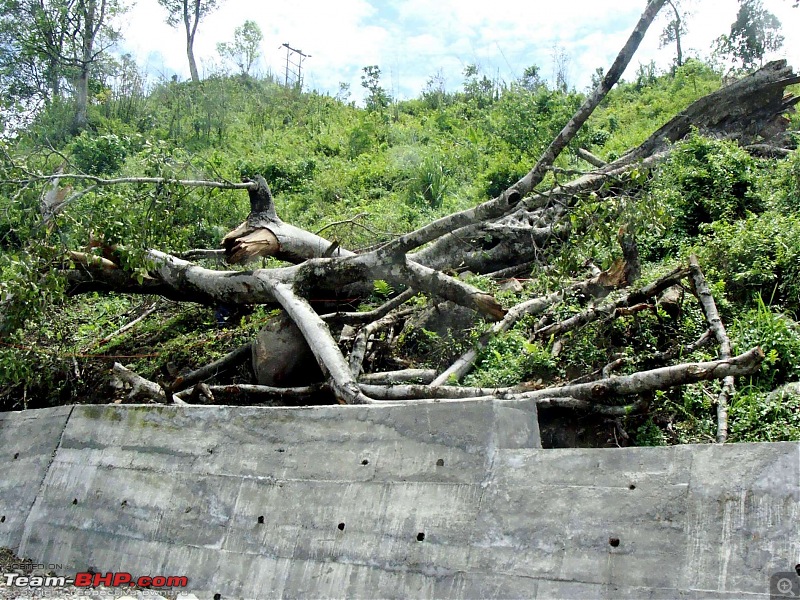
So, with one last wistful look at the road across the river leading up to Eagle Nest Bird Sanctuary...
...we are on our way to Bhalukpong, and onwards to Tezpur.
We are back in the plains of Assam, but we still lust for some more places to go to.
On the way back from Bhalukpong to Tezpur is the Nameri Tiger Reserve - and even if we do not get to see any tigers here, we can at least enjoy ourselves staring into the lush green jungle, and imagining a few black and yellow stripes that can barely be glimpsed in the shadow! :)
Or how about an elephant (or four) lumbering out of the forest right before us?
Right now, the only elephants we get to see are these. But maybe there are more hiding inside the forest...
Ever the optimist, we head off onto a dirt track, in search of the Forest Office and the Eco Camp.
This weekend, while surfing the tv, I came across a travel show about great road trips. The moment I saw a lake with the tree stumps I shouted out "This is in Tawang" - having read through your brilliant travelogue with great interest :D.
Just wanted to share!
Sadly for us, the Nameri Forest is closed to visitors for the next few months. The Eco Camp is still in business, but doesn't appeal to us any more since a trip to the forest wouldn't happen. By then Sutripta-da has decided to be the generous host as usual, and wants to take us along to Tezpur to stay overnight. But that is not before we continue further on the dirt track to the banks of the Jia Bhoreli river.
It is not tiger territory on this side of the river - children are on their way back from school; jackfruit-laden trees and shrubs full of hibiscus line the roads; and the sight of the river ahead is beautiful.
However, as soon as the engine is switched off and we open the doors, the oppressive humidity and searing heat slam into us like punches to the face. We had completely forgotten that we are in the plains of Assam now, the excellent air-conditioning in the car had not let us feel the heat outside - and we are dressed in heavier clothing than the weather warrants.

Across the river is the forest - we look longingly at the greenery in the far distance; there's not even a boatman to take us across.


The lone buffalo is the only life form we find on the banks of the river, on the other side. It would be a spectacular sight to have a tiger arrive there to hunt, but obviously that is not going to happen! No harm in daydreaming, though. :)

Should be a lovely place to stay in. No idea what this is.
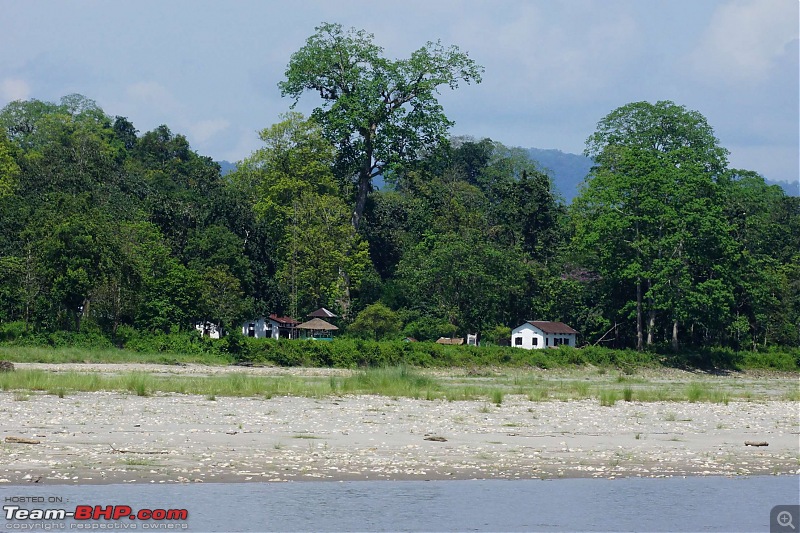
The cloudy mountains of Arunachal that we just came down from.
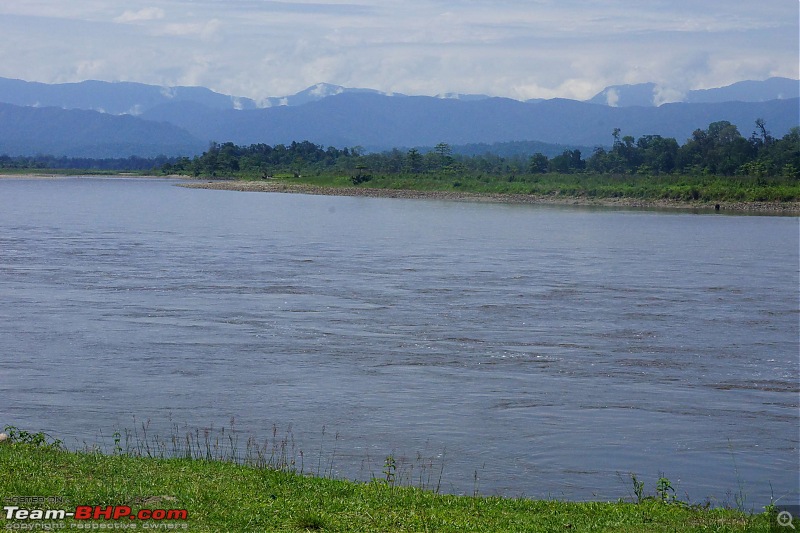
Finally, after a short while of enjoying the scenery (and suffering the heat and humidity), we turn around and head towards Tezpur.
Tezpur. A proper sit-down multi-cuisine dinner menu at a restaurant called KF (not to be confused with KFC) after quite a few days. Sutripta-da complains about how irritating the behaviour of folks is, who fire off flashes, disturbing the other diners at a restaurant. I'm guilty too! :)
Tezpur has a lot of exotic flora and fauna, if you're looking carefully.
And this would be the first time we get to pluck lychees fresh off a tree and eat them.


Then it is time to drive to Guwahati once again, in the pouring rain. This time, along the north bank of the Brahmaputra.
| All times are GMT +5.5. The time now is 19:46. | |


















